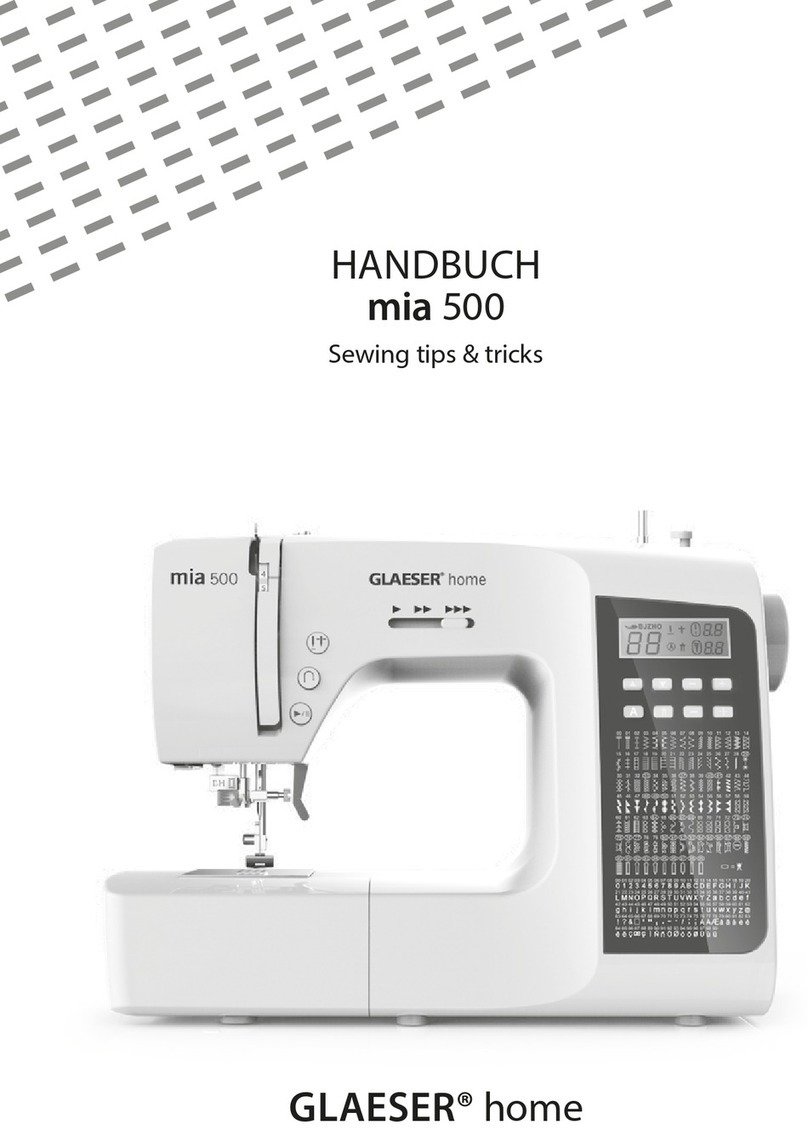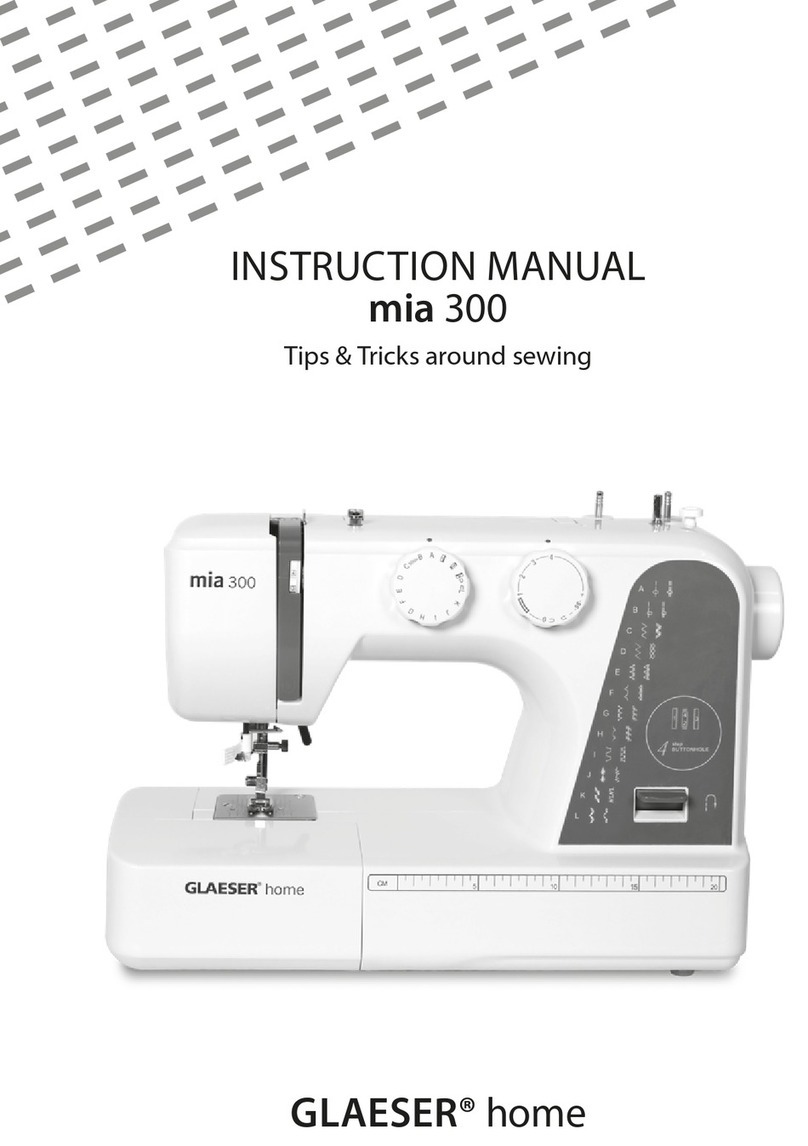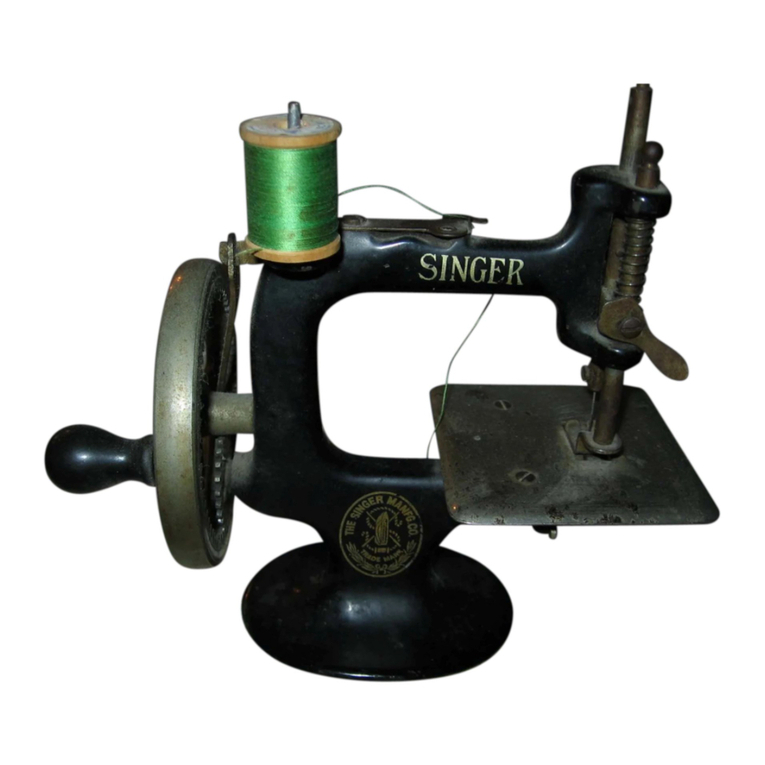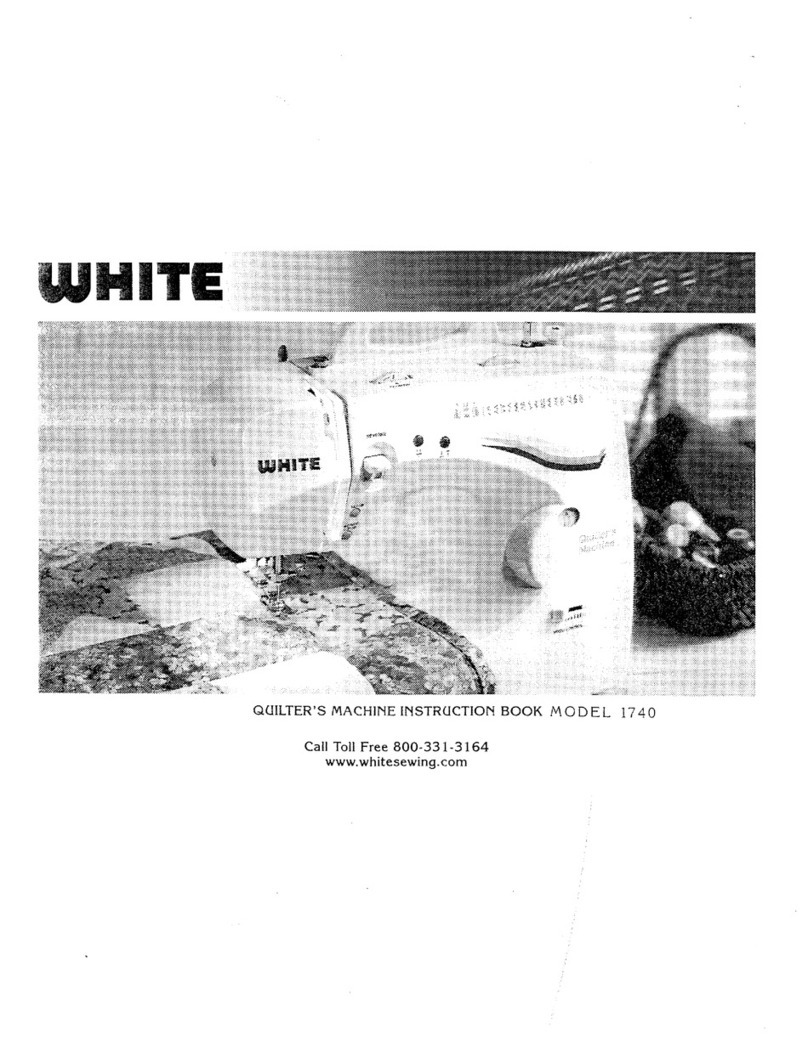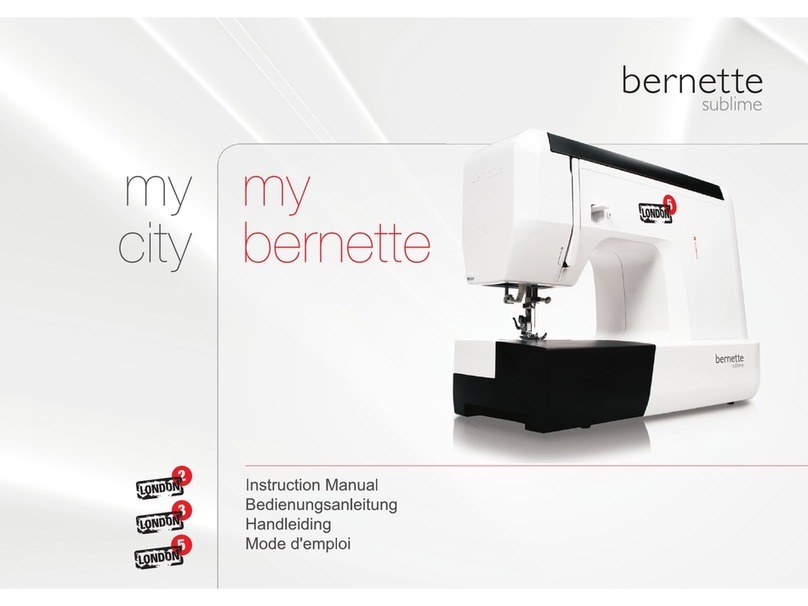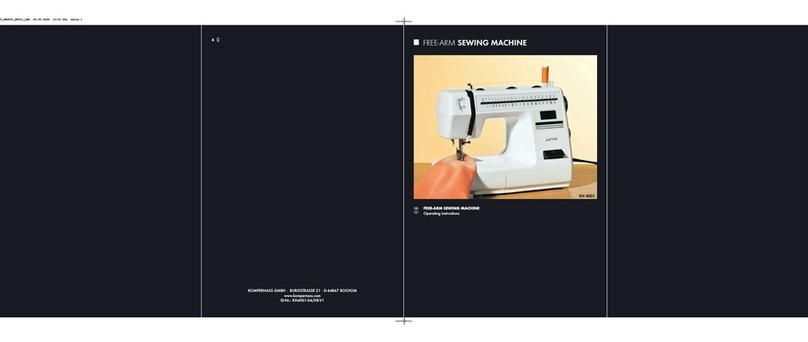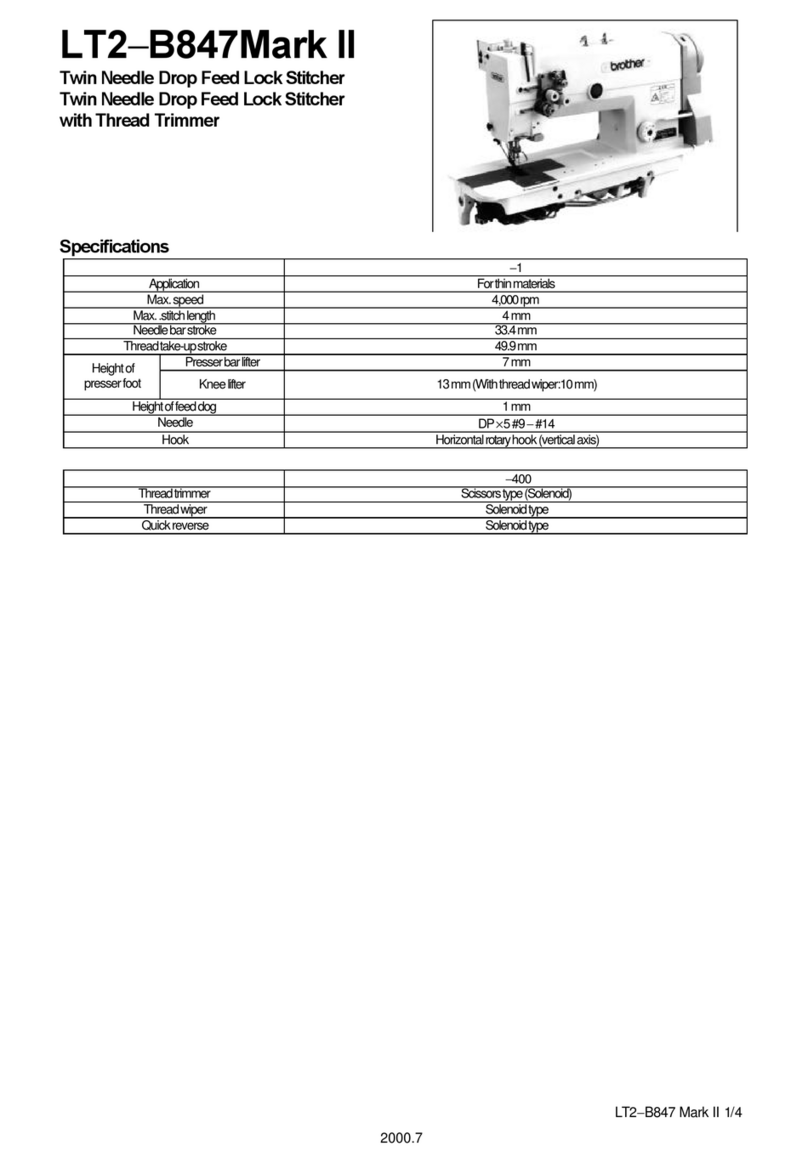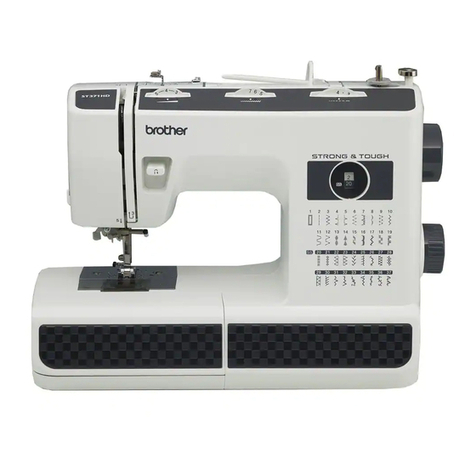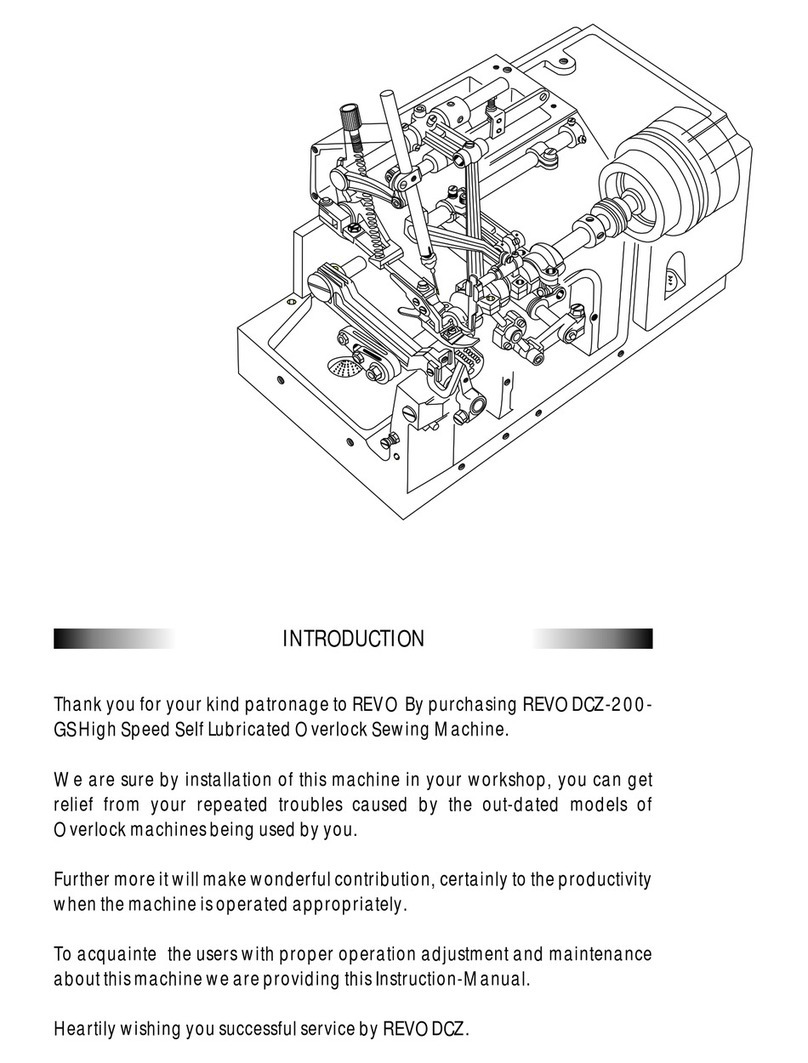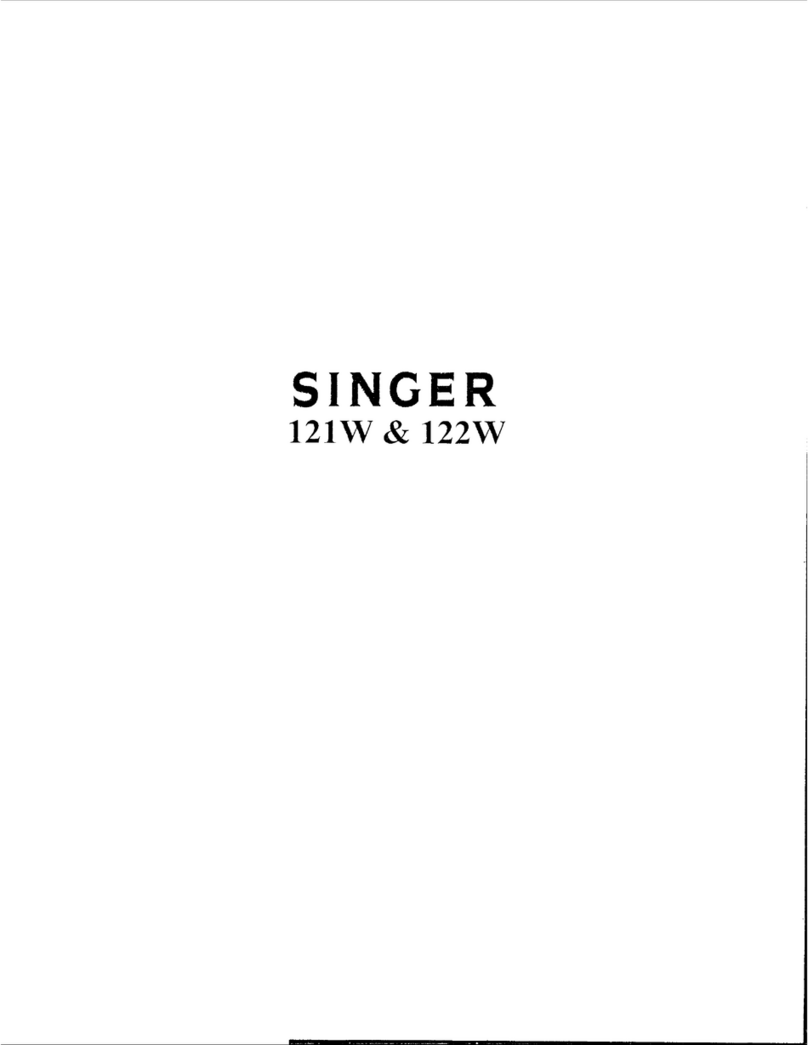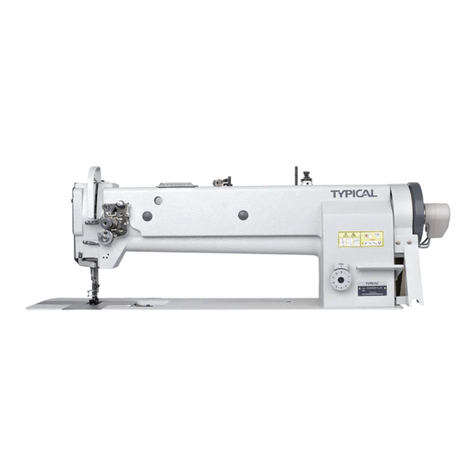Glaeser home mia 350 User manual

USER MANUAL
mia 350
Sewing tips & tricks
GLAESER® home

2 3
For more tips & info, visit
the download page at
www.glaeser-home.de/en
CONTENTS
Important safety instructions.................................................................................................................4
GET TO KNOW YOUR SEWING MACHINE
Part designations ........................................................................................................................................6
Standard equipment..................................................................................................................................6
PREPARATIONS FOR SEWING
Connecting the machine to the power supply................................................................................ 7
Sewing in reverse........................................................................................................................................ 7
Presser foot lifter .........................................................................................................................................7
Replacing the sewing foot.......................................................................................................................8
Extension table / free-arm sewing .......................................................................................................8
Stitch selector...............................................................................................................................................8
Replacing the needle................................................................................................................................. 9
Winding .......................................................................................................................................................10
Inserting the bobbin................................................................................................................................11
Threading the machine ..........................................................................................................................12
Fetch bobbin thread upwards .............................................................................................................13
Adjusting the upper thread tension ..................................................................................................14
SEWING BUTTON HOLES
Sewing a buttonhole...............................................................................................................................15
MAINTENANCE OF YOUR MACHINE
Cleaning the feed dog ............................................................................................................................16
Installing the feed-dog unit..................................................................................................................16
Troubleshooting........................................................................................................................................17

4 5
IMPORTANT SAFETY INSTRUCTIONS
When using an electrical appliance, basic precautions including the following should always be
followed:
Read the complete instructions before operating this sewing machine.
DANGER - To reduce the risk of electric shock:
Unplug the power cord immediately after use and before cleaning.
WARNING - To reduce the risk of burns, re, electric shock or personal injury:
1. The sewing machine is not a toy. Increased caution is advised when the sewing machine is used
by or near children.
2. This appliance can be used by children aged from 8 years and above and persons with reduced
physical, sensory or mental capabilities or lack of experience and knowledge if they have been
given supervision or instruction concerning use of the appliance in a safe way and understand
the hazards involved. Children must not play with the appliance. Cleaning and maintenance
must not be carried out by children without supervision.
3. This sewing machine may only be used for the intended purpose described in this operating
manual. Use only accessories recommended by the manufacturer and covered in these instruc-
tions.
4. Never use the sewing machine if the cables or plugs are damaged, the machine does not func-
tion properly, has fallen to the ground or been damaged, or has even fallen into water. In such
cases, take the sewing machine to the nearest dealer or service center for inspection, repair or
electronic or mechanical readjustment.
5. Use the sewing machine only when no ventilation openings of the machine and the foot control
are blocked and keep them free of lint, dust and fabric residues.
6. Never insert objects into openings in the sewing machine or allow them to fall inside the
machine.
7. Do not use the sewing machine outdoors.
8. In addition, do not use the sewing machine in places where propellant gas products (sprays) or
pure oxygen are used.
9. To turn o the machine, set the power switch to the "0" position and then disconnect the power
plug from the power outlet.
10. Always pull the plug and never the cord when disconnecting the machine from the power
supply.
11. Keep your ngers away from all moving parts. Particular care must be taken in the area of the
sewing needle.
12. Always use the original needle plate. The use of an incorrect needle plate can cause the needle
to break.
13. Do not use bent needles.
14. Do not actively pull or push the fabric during sewing. This can lead to deection of the needle
and thus to needle breakage.
15. Switch o the machine (switch position "0") before you perform any activities in the needle
area, such as threading, changing the needle, changing the presser foot, and the like.
16. Always disconnect the sewing machine from the power supply before removing covers, oiling
the machine or any other oil the machine or carry out any other work intended to be performed
by the user and specied in this operating manual.
17. Observe the following to avoid injuries:
· Turn o the machine or unplug the power cord when leaving the machine unattended.
· Unplug the power cord before performing maintenance or replacing lamps.
CAUTION: Moving parts! To reduce the risk of injury, turn o the sewing machine before servicing.
Close the cover before operating the machine.
KEEP THIS INSTRUCTION
This product is intended for household or equivalent use.
This device complies with the EMC Directive 2014/30/EU for electromagnetic compatibility.
When disposing of this product, please note that it must be safely recycled in accordance
with the relevant national legislation relating to electrical/electronic products. If in doubt,
please contact your retailer for advice.
The design and specications are subject to change without notice.

6 7
GET TO KNOW YOUR SEWING MACHINE
PART DESIGNATIONS
SEWING IN REVERSE
As long as you press the " reverse stitch control"
button during sewing, the machine will feed the fabric
to the rear.
STANDARD EQUIPMENT
1. bobbin
2. seam ripper
3. screwdriver
4. sliding buttonhole foot
5. needle set
2. handle
yarn spool pin
handwheel
power switch
machine socket
free arm
sewing foot lifter
PRESSER FOOT LIFTER
1. Presser foot lifter
2. Standard upper position
The sewing foot lifter raises and lowers the
sewing foot.
PREPARATIONS FOR SEWING
Connecting the machine to the power supply
1. mains plug
2. mains switch
3. power socket
4. machine socket
5. machine plug
Before connecting the power cord, make sure that
the voltage and frequency displayed on the machi-
ne matches yours.
1. turn o the power switch
2. insert the machine plug into the machine socket
3. insert the power plug into the power socket
4. turn on the power switch to turn on the power
and the power supply of the sewing lamp.
13
16
14
17
1. stitch selector
bobbin winder stopper
bobbin winder spindle
bobbin winder tension disk
take-up lever
upper thread guide
thread tension wheel
needle
stitch plate
dimension bar
sewing foot
reverse stitch control
1
5
9
2
6
10
3
7
11
4
8
12
12
15
18
19
1
4 5
2 3
1
1
2
3
4
5
6
8
9
712
11
10
1
2
3
4
5
22
1
14
15
19
18
16 17
13
19

8 9
REPLACING THE SEWING FOOT
1. lever
2. nut
3. pin
To remove the presser foot:
Turn the handwheel in your direction to move
the needle to its highest position. Raise the
presser foot. Press the lever on the back of the
foot holder. The presser foot comes o.
Insert a presser foot:
Place the presser foot so that the pin on the
foot is aligned directly under the groove of the
foot holder. Lower the foot holder to secure
the foot.
EXTENSION TABLE / CONVERSION TO
Removing the table
Pull the table (1) away from the machine to the
left as shown, e.g. to sew cus and sleeves "free
arm" (2). The slide-on table can be used as an
accessory box.
Attaching the table
Carefully slide the extension table into the ma-
chine from left to right until it locks into place.
STITCH SELECTOR
Raise the needle above the fabric. Turn the dial
to select the desired pattern.
CAUTION: To avoid needle or fabric dama-
ge, make sure the needle is up or out of the
fabric while selecting a stitch.
REPLACING THE NEEDLE
1. Needle clamp screw
2. Needle clamp
3. Needle side
1. Turn o the power switch
2. Raise the needle to its highest position
by turning the handwheel counterclock-
wise towards you and lower the presser
foot.
3. Unscrew the needle clamping screw (1) by
turning it counterclockwise.
4. Remove the needle from the needle clamp.
Now insert a new needle into the needle clamp
with the at side (3) facing backwards. Push the
needle up as far as possible when inserting it
into the needle clamp (2).
Tighten the needle clamp screw (1) by turning
it clockwise.
CAUTION:
Never use a bent or dull needle!
A damaged needle can cause permanent hang-ups or running
stitches in knitwear, ne silk and silk-like fabrics.
To check whether a needle is bent, place the at
side of the needle on a at surface (e.g. stitch
plate or glass plate): The distance between the
needle and the at surface should be even.
1. Setting mark
2. Stitch selector
FREEARM SEWING
2
1
1. extension table
2. free arm
2
1
1
2
1
3
1
2
3
1
2
3
1
2
3
1
2
1
2

10 11
WINDING
The thread spool holder is located on the back
of the sewing machine. Pull out the thread spool
pin. Place the feet and the bobbin in the correct
order.
The thread end should come o the spool as
shown.
thread spool pin
guide hook
thread spool
1. Disengage the clutch by pulling out the
hand wire. This will prevent the needle
from moving while you wind the bobbin.
2. Pull the thread from the thread reel. Guide
the thread around the thread guide.
3. Pass the thread between the tension
discs. (Thread through the hole in the
bobbin from the inside to the outside).
4. Place the bobbin on the bobbin winder
spindle.
Slide the bobbin to
the right.
Hold the free end of
the thread. Press the
foot pedal. Stop the
machine, when it has
made a few revolu-
tions, cut the thread
near the hole in the
bobbin.
Press the foot starter
again.
When the bobbin is
fully wound, it will
stop automatically.
Return the bobbin
winder to its original
position by moving
the spindle to the left.
Then cut the thread.
Press the handwheel
to the left to engage
the clutch.
The machine does
not function until the
clutch is engaged.
1. Place a bobbin in the bobbin case and make
sure that the thread is guided clockwise by
the bobbin.
2. Pull the thread through the slot in the
bobbin case.
3. Then pull the thread 10 cm through the
opening under the thread tensioner.
4. Hold the bobbin case by the ap latch and
insert it into the hook of the machine.
INSERTING THE BOBBIN
1
2
3
2
4
1
3
3
5. 6. 7. 8.
1
2
2

12 13
THREADING THE MACHINE
Place a thread spool on the spool pin so that the thread comes out as shown in Figure 1.
Then raise the thread lifter to its highest position by turning the handwheel counterclockwise
towards you. Raise the presser foot.
Guide the thread end
around the thread
guide.
(1) Thread guide
1. thread guide
2. tension discs
3. control thread holder
4. slotted eyelet
5. needle
Guide the thread bet-
ween the tension discs
and then around the
control thread holder
as shown around the
control thread holder.
Pass the thread from
right to left through
the slotted eyelet
and then down to the
needle.
Push the thread from
the left behind the
thread guide of the
needle and then
thread the needle
from the front to the
back.
Figure 1
FETCH BOBBIN THREAD UPWARDS
1. Raise the sewing foot. Now hold the needle thread with your
left hand and turn the handwheel counterclockwise towards
you for one complete revolution.
2. Bring the bobbin thread up by pulling lightly on the needle
thread.
bobbin thread
needle thread
3. Pull both threads 10 to 15 cm under and behind the sewing
foot.
1
2
3
1
2
4
5
1
3
4
5
2
1
4
1
1
2
2. 3. 4.1.

14 15
ADJUSTING THE UPPER THREAD TENSION
Balanced Tension
In the ideal degree stitch, the threads are sewn between two layers of fabric, as shown.
Turn the dial to ad just the tension
G) To loosen ® To tighten
The tension requires adjustment depending on:
- stiness and thickness of the fabric
- number of fabric layers
- type of stitch
· Tension is too tight
G) Needle thread (Top thread)
® Bobbin thread (Bottom thread)
@ Right side(Top side)of fabric
@ Wrong side(Bottom side) of fabric
® To loosen
II the bobbin thread shows through on the right side(top side) of the
fabric , turn the dial to a lower tension setting number to loosen the
needle thread tension.
• Tension is too loosen
G) Needle thread (Top thread)
® Bobbin thread( Bottom thread)
@ Right side(Top side)of fabric
II the needle thread shows through on the wrong side(bottom side)
of the fabric, turn the dial to a higher tension setting number to
tighten the needle thread tension.
@ Wrong side(Bottom side) of fabric
® To tighten
Adujusting the Needle Thread Tension
· Balanced tension
The ideal straight stitch has threads locked between to layers of
fabrics , as illustrated.
G) Needle thread (Top thread)
® Bobbin thread (Bottom thread)
@ Right side (Top side) of fabric
@ Wrong side(bottom side) of fabric
1. upper thread
2. bobbin thread
3. right side (top side) of the fabric
4. left side (bottom side) of the fabric
The voltage must be adjusted according to
the following criteria:
- stiness and thickness of the fabric
- number of fabric layers
- stitch type
Tension is too tight
If the bobbin thread shows through on the top side of the fabric, turn the dial to a lower tension
setting to loosen the top thread tension.
upper thread
lower thread
right side
(top side) of the fabric
left side
(bottom side) of the fabric
to release tension
The tension is too loose
If the needle thread shows through on the underside of the fabric, turn the dial to a higher tension setting to
increase the needle thread tension.
upper thread
lower thread
right side
(top side) of the fabric
left side
(bottom side) of the fabric
to tighten
Set the stitch
selector to
and sew until you
have returned to the
start mark of the but-
tonhole. have come.
Stop sewing with a
right stitch.
SEWING BUTTON HOLES
To sew buttonhole you will need:
1. stitch selector
2. upper thread tension
3. buttonhole sewing foot
THIS IS HOW IT`S DONE
1.
Attach the buttonhole sewing foot as described
on page 8.
Carefully mark the buttonhole length on the
fabric. Place the fabric under the foot so that
the buttonhole mark is facing you.
Move the slider (A) towards you so that the top
mark (C) on the slider aligns with the start mark
(B). Lower the presser foot.
Set the Stitch
selector to
and sew forward until
you reach the front
mark of the button-
hole. Stop sewing
with a left stitch.
Set the stitch
selector to
Sew 4-6 stitches. Stop
sewing with a right
stitch.
Set the stitch
selector to
and sew 4-6 stitches.
Stop sewing with a
left stitch.
Remove the fabric and insert a pin at each end
end just before the bartack to prevent the barta-
cks from cutting through. Cut the opening with
the buttonhole opener.
NOTE:
When sewing a
button hole on one
edge of the fabric, set
the end seam to slide
backwards as shown.
Turn the dial to adjust the
tension only
5. loosen
6. tighten
1
2
3
4
1
2
3
4
1
2
3
4
5
5
5
6
1 2 3
BA
C
2 3 4 5
1
2
3
4
1
2
3
1
2
3
4
5
1
2
3
4
5
5
6
3. 4. 5.2.
6.

16 17
Error Causes Solution
upper thread breaks
Upper thread threaded improperly. Thread the upper thread again (see
page 12).
Upper tension too tight. Adjust upper tension (see page 12).
Blunt or bent needle. Replace needle (see page 9).
Improper xation of the needle. Reinsert needle (see page 9).
At the beginning of sewing, upper
thread and bobbin thread are not
properly xed under the presser.
Proper operation.
The thread is not suitable. Replace thread.
lower thread breaks The bobbin thread is not threaded
correctly in the bobbin case.
Thread the bobbin thread again
(see page 31).
Cotton ocks are collected on the
shuttle track. Clean the shuttle web (see page 47)
The bobbin is damaged and can-
not deliver thread evenly. Replace bobbin (see page 27)
needle breaks
Improper xation of the needle Replace needle (see page 9).
Blunt or bent needle Replace needle (see page 9).
Needle clamping screw is loose. Tighten needle clamping screw
Excessively tight upper tension Adjust upper tension (see page 14)
Needle too thin Insert correct needle (see page 9)
MAINTENANCE OF YOUR MACHINE
NOTE:
Turn o the power switch and/or disconnect the power plug before cleaning the machine. Do
not disassemble the machine other than as described in this section.
Cleaning the feed dog
1. Remove the needle and sewing foot. Remove
the throat plate screw (1) and the throat plate.
2. Clean with a brush and remove dust and lint.
They could clog the feed-dog line.
3. Reset the throat plate.
1. Move the needle to the highest position and open the hook cover.
2. Open the bobbin case ap and remove it from the machine.
Open the bobbin case ap and remove the bobbin case (1). Turn the handwheel until the hook path
is on the left (2). Turn the two hook holders (3a) outward and remove the hook track with hook.
Clean with a soft cloth and lubricate with sewing machine oil (1-2 drops).
Installing the feed-dog unit
Pay attention to the alignment of the gripper
unit (pos. 6 below). Insert the hook (4) so that it is
on the left. Then fasten the hook track (3b) with
the two hook holders (3a), making sure that the
pin (5) is seated in the recess (6). Now you can
reinsert the bobbin.
Reinigen des Transporteur-Bereichs / Demontieren der Transporteur-Einheit
TROUBLESHOOTING
bobbin capsule
hook track
hHook holder
gripper track
gripper
pin
recess
6
5
3b
1
2
3a
4
1
2
3a
4
5
6
3b
1

18 19
stitches are skipped Improper xation of the needle. Reinsert needle (see page 9).
Blunt or bent needle. Replace needle (see page 9).
The needle and (or) thread are not
suitable for the fabric used.
Replace needle and thread
(see page 9).
Improperly threaded. Re-thread upper thread
(see page 12).
The needle is not suitable. Select suitable needle, e.g. jersey
or microtex needles.
seams pucker Excessively tight top tension. Adjust top tension (see page 14).
Improperly threaded. Thread upper thread again
(see page 12).
Upper thread too thick for the
fabric used. Replace thread .
uneven feed Feed dog is blocked by threads. Clean feed dog (see page 16).
Thread jammed. Loosen jammed thread
machine does not
run The mains plug is not securely
connected.
Check mains connection
(see page 7)
The thread is jammed at the
shuttle. Loosen jammed thread.
The bobbin winder shaft has not
been returned to the original posi-
tion (after bobbin winding).
Push bobbin winder shaft to origi-
nal position (see page 11).
thread error The presser foot lifter has not
lowered during sewing.
Lower the sewing foot lifter
(see page 7)
Upper thread threaded improperly. Thread upper thread again
(see page 12).
Lower thread improperly threaded. Thread the bobbin thread again
(see page 13).

Aalen branch | Benzstr. 5 | 73431 Aalen
Marktoberdorf branch | Kaufbeurener Str. 74 | 87616 Marktoberdorf
Mindelheim branch | Krumbacher Str. 38 | 87719 Mindelheim
Renningen branch | Weil der Städter Str. 51 | 71272 Renningen
Ulm branch | Blaubeurer Str. 263 | 89081 Ulm
www.glaesertextil.de
6–99
www.glaeser-home.de/en
diversity
fabrics
sewing classes
accessories
home textiles
Table of contents
Other Glaeser home Sewing Machine manuals
Popular Sewing Machine manuals by other brands
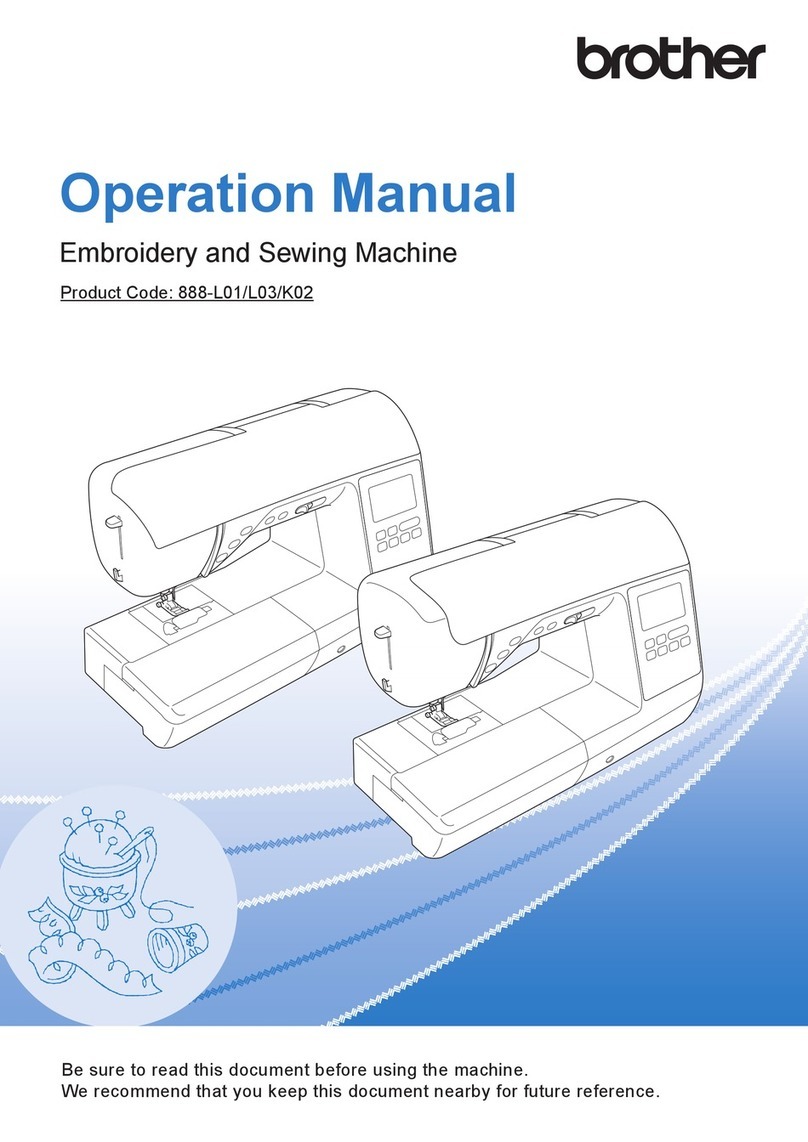
Brother
Brother 888-L01 Operation manual
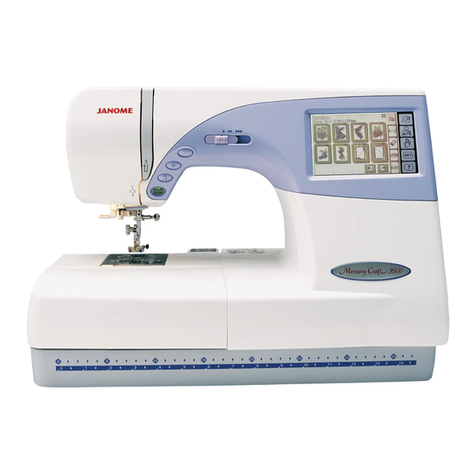
Janome
Janome MEMORY CRAFT 9500 instruction manual
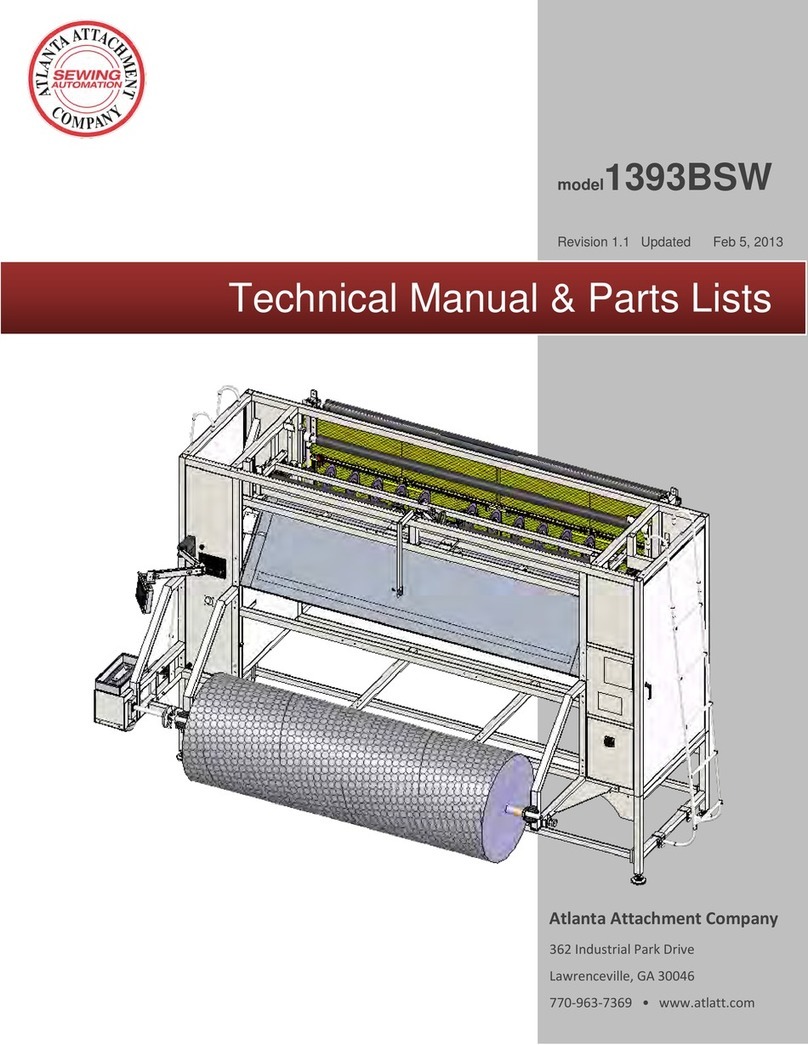
Atlanta Attachment Company
Atlanta Attachment Company 1393BSW Technical Manual & Parts Lists
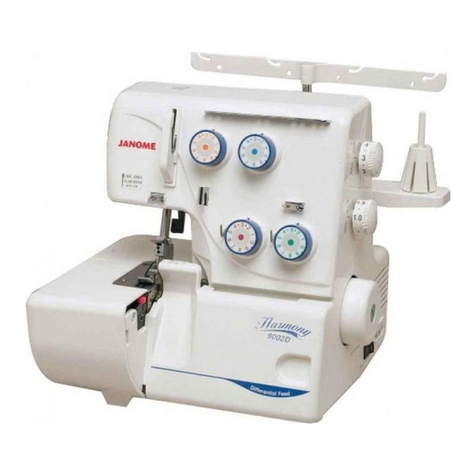
Janome
Janome myLock 134D Instruction book
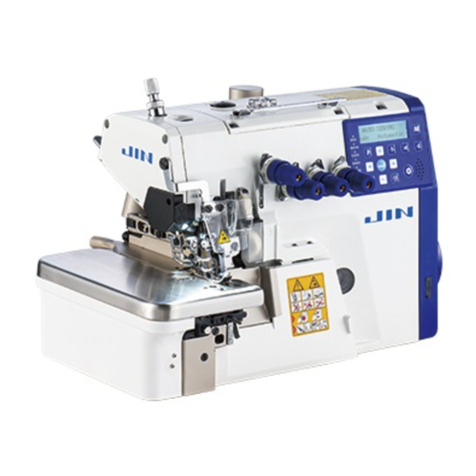
JUKI
JUKI M-1 Series instruction manual

UnionSpecial
UnionSpecial 3100A Instructions and parts list
